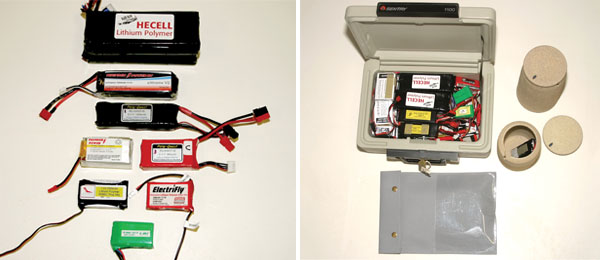
Written by Greg Gimlick Helicopters Column As seen in the Winter 2018 issue of Park Pilot.
>> One of the things you’ll run into if you do much park flyer-size helicopter flying is the variety of batteries and connectors you’ll accumulate. It seems that every manufacturer has its own idea about what size or type of helicopter connector to use. That puts the end user in a predicament—but not one that has to be a problem. It simply takes a little research and careful buying to take the stress out of supporting your fleet.

These four helicopters and a quad all use different packs and connectors. This can be a problem when it comes time to charge batteries.
In the above photo are several aircraft. Each takes a different type of battery or connector. The Blade Night 230 S (bladehelis.com) in the rear uses two types of batteries because the blades each have their own single-cell LiPo battery to power the lights. All of my park flyer aircraft use small packs, but they vary from 1S to 3S and use four different connectors. If I add the rest of the small quadcopters to the mix, the problem becomes bigger. You’ll want to identify your connectors. These probably include an mCX (officially a 1.25mm PicoBlade from Molex [molex.com]), mCPX (officially a JST PH 2.0 [jst.com]), JST (also called a BEC), and a Molex. Confused yet? To add to the confusion, some quads use plugs that are adapted balance plugs, but they aren’t yet common enough to fret about. After you’ve identified your connectors, you can shop for parallel boards so that you can charge several at a time. This assumes that you already have a charger ...

In this collection of battery packs from Greg’s park flyer-size helis, nearly everything has a different connector.
There is no shortage of charger options. The problem is making the best choice to minimize expense and the amount of gear you need to haul around. If you have a charger that you use for your larger airplanes or helis, you only need to shop for adapters or parallel boards. You probably have several USB charger dongles that came with some of the smaller helis. The problem is that you can only charge one battery at a time and you need a USB port. Most late-model cars come equipped with USB ports, so that might not be a big deal. For my 1S machines, I prefer a charger that has more than one type of connector and will charge multiple packs. The EV-Peak charger (ev-peak.com), available from Bang Good (banggood.com), handles four single-cell batteries at a time, each of a different size with different connectors and voltage.

Each of these chargers has its own list of pros and cons. Define your needs and choose the charger that best fits them.
That accommodates the high-voltage packs for my Inductrix, but also the smaller mCX connector packs for my Night 230 S blades and coaxial aircraft. Each output is independently controlled. It can be powered with an AC cord or a DC source from 9 to 12 volts. Another great choice if you only have packs using mCX or mCPX connectors is the STRIX Power Stix from Ready Made RC (readymaderc.com). This charger is powered by a larger LiPo battery pack that is connected to an XT60 connector on the end. Charging is automatic, and the device comes in two versions: one for regular LiPo batteries and the other for high-voltage versions. Make sure to order the appropriate version. It charges up to six packs at a time. For approximately $15, you can’t go wrong. The versatility prize goes to my humble, little iSDT SC-608 charger (isdt.co)! It will accommodate packs up to 6S and accept up to a 32-volt input via the XT60 connector on the back. The balance port is built into the side, along with another XT60 connector for the output.

Parallel boards can be handy if you already have a charger.
Although this setup requires me to use a balance board to charge multiple packs, it is capable of charging my larger 3S packs or even up to 6S single packs. It’s a pocket-size 150-watt charger that is hard to beat and extremely intuitive to use. It costs more at approximately $45, but it’s worth every penny. Do some homework and take stock of your packs, connectors, and needs. When you have it laid out in front of you, you can decide which type of charger best fulfills your requirements. Buy smart the first time and you’ll have more money for the fun stuff. Heck, you can learn from my mistakes! One more quick tip is that these tiny one-cell packs don’t have the longest life, so don’t waste a lot of money stocking up. Buy enough to keep you going and when they start to decline, look for a deal on another four- or six-pack of them. Buying 24 packs just to have them all die at the same time isn’t the smartest move. I won’t mention how I know that. -Greg Gimlick [email protected]
Article:





